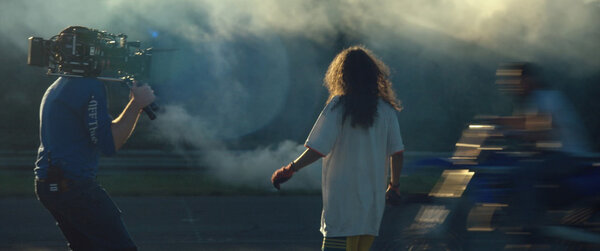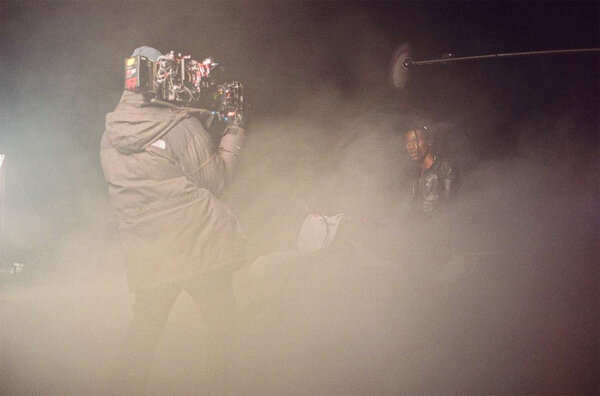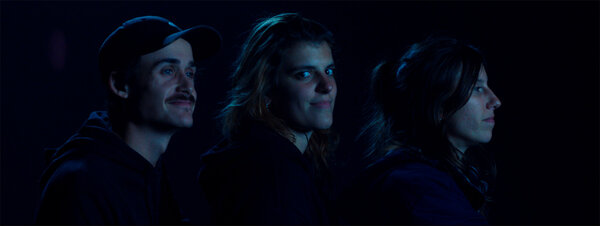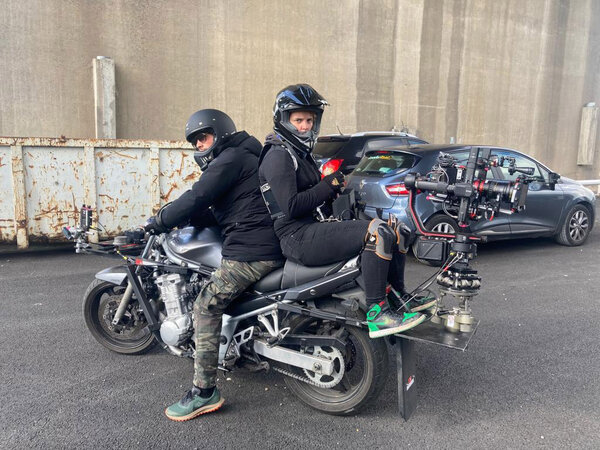Cinematographer Raphaël Vandenbussche discusses his work on "Rodéo", by Lola Quivoron
Raphaël Vandenbussche : Skin is the subject of the film. It was the subject of my graduation thesis and here the skin is scratched, the skin is burnt. There is the choice of the handheld camera. The idea is to always be surprised. By beauty too. So we chose this fairly close camera that has a lot of desire. Lola loves this character, and so do I, so we filmed her up close. I was absorbed by Julie Ledru, the main actress. We ran, danced, rode together for twenty-seven days. We had the same struggles, the same joys, the same obstacles. This complicity made it possible to grasp something that I hope was embodied. Lola is a photographer and has known Bikelife for a very long time. She had made it the main subject of her short film Au loin Baltimore, in 2016. She knows all of its visual codes. Urban motocross is a practice that started in working-class neighborhoods in the United States and arrived in France in the 2000s. It has become very popular in our working-class neighborhoods. Lola invited me into this universe. I’m not yet able to handle a 450CRF, but I’m not afraid to ride a scooter anymore.

Lola worked a lot with her actors beforehand. So much so that they had a very acute knowledge of their character. There were some written dialogues that served as a compass.
It’s like making a fire. You’ve got oxygen, the wood. Then the spark. We did a first improvised take, hand-held camera, just to warm up the embers. A very long take. Often fifteen, twenty minutes. Then we analyze the smoke. And we go straight into another long take. Then we dance with the sparks. Until we get burnt.
Leaving such a lively, tenacious, surprising character behind at the end of the film was hard. I wanted to spend the rest of my life with Julia. I find the character so beautiful, a young woman who demands respect and refuses the codes that others want to impose on her in a milieu that is as masculine as Bikelife. I am so happy to have had the opportunity of lighting such a powerful character.
We identified the film’s style on the basis of a little book by artist Federico García Lorca, Theory and Play of the Duende, in which he describes what occurs in Flamenco dancing. Somewhat like a magical enchantment. It’s a power we have in our bodies that allows you to have a feeling, that allows you to go beyond the real and seize what is the “permanent baptism of freshly-created things.” It’s what riders look for when they get on their motorcycles : the flow. Not to feel the weight of the machine. We tried to have the same feeling with the handheld camera. For everything to be fluid. For the anamorphic Masters to be light. There’s a real abandon in shooting that is so pleasant. You disarm yourself and get naked. It’s such a gift. Of the body, nothing remains but for the solid link to the earth. But you fly. Light.
The camera won’t catch shots, but rather shots will invite themselves into the camera, and everything comes together. Lola knows how to take care of her crew, and of the film. She often would say to me : “I like when your body can be felt”. That’s rare. Usually, I’m asked to be invisible, for the camera not to be there. But there, if I go into it, if the actor makes a detour to avoid me, if I catch my feet in the rug, it’s an event. And she’s right. In the film, you can feel that the camera is someone. It’s not an obstacle, but something that can burn and fall.

What were your inspirations ?
RV : Lola liked a music video I had filmed for the artist Niska called "Silicone". She liked that spirit for the film, a rhythmic camera. We quickly had a mutual feeling. We’d talk about our emotions, it was very fluid and pleasant. I am not an interpreter. It’s more about trust. She trusted me a lot and I’m delighted.
We wanted to create our own image on Bikelife because it’s a world that hasn’t been filmed much - not in France anyway. For the energy of the camera, there is obviously Rosetta, by Jean-Pierre and Luc Dardenne. Where we let ourselves be surprised by the physicality and the beauty of the actress. Yet who eludes us.
For the interior of the image, Lola gifted me a book by French photographer Gaël Bonnefon, Elegy for the Mundane. There was a photo on the cover of the book that we really liked. It was quite contrasted with a lot of grain and coldness in the shadows. Definitely cross-processed. With a flash. I looked at that photo every day in my apartment hotel room. That was the guiding image. It provided the colors, grain and contrast on this film, which colorist Arthur Paux and I went after when making the unique LUT for filming.

Arthur has this way of tilting his head to the side while adjusting the colors, which reminds me of a double bass player improvising and giving colors to the melody. He is an exceptional performer. And very much a music lover. Every night, I’d come home with a new playlist. Also, we added grain to the digital image, which always reminds me of a tombstone, polished granite or asphalt gleaming in the sun. This scanned grain mixes with the grain of the skin captured by the Alexa at 1600 ISO. The skin then becomes thick. It imparts desire, sensuality. We completed color grading of the film fairly quickly, in ten days at MicroClimat, on a sublime Scope screen.
The marvelous costumes were designed by Rachèle Raoult. In them, were already the substance of each scene, the first features of the characters, and the material too : the coal, the blood, the sheen. It all contributed to the organic nature of the image. Anamorphic helped too. And the Scope was essential for filming Rodéo. The motorcycles break this format when they rise up like a letter i. Frédéric Valay, from TSF, suggested the Masters which I adored, in particular the 28mm which is very impressive.
I knew that our approach to shooting this film would be possible when Camille Autrive said yes to it. Camille is not afraid of anything. Improv, no rehearsal, anamorphic, full aperture, handheld camera, actors. It never fell apart. Two of us were behind the camera. With Camille, Juliette and Florence, I felt like I could do anything. Duende. I was never aware of the camera. Just from a friendly object that would sometimes come and lay its head on my shoulder. Four hours of dailies every day. Camille is really unique. She can be hidden in a fridge, behind a plant, on a motorcycle : no problemo.
How did you light this film ?
RV : Natural light was our starting point. And we always filmed at 360°, so there were few or no tripods in the truck. Thomas Le Fourn, the chief electrician, in whom I have full confidence, and I would add in small touches of contrast or colors. Often with 2.0 tools (Astera, Aladdin, SkyPanels), which he handles with perfect mastery. And so quickly. The sets were very beautiful, designed by Gabrielle Desjean, in collaboration with us. So, I was sure to have a nice little skylight or a well-placed neon. Also, the light was often perched, which made me laugh a lot when Thomas was on my left, because I saw him waddling around with a FabricLite that we called the Moon.

Can you tell us a bit about the Bandicam ?
RV : We had already used the Bandicam belonging to Laura Marret, the key grip, which she created with Mathieu Lardot, stuntman, on Garçon chiffon. They made a new one, the Bandicam 2. It’s a high-powered motorcycle you can attach the Ronin to the front or the back of, and I’m in a vehicle next to it, with Master Wheels, a WiFi camera control module. This setup allows you to be very close to the actress. At 28mm, it’s insane. And when there are thirty motorcycles, with the Bandicam in the middle of the swarm, it is very exhilarating. Technically speaking, it is quite simple, and it is quick to setup. I had storyboarded the stunts and the rolls. Often, Laura rode on the Bandicam with Mathieu to communicate with the actors, and with me. It is very eloquent piece of equipment that allows for changes in camera shots, from a wide shot to a close shot. Duende. The motorcycle shots are the most stable ones in the whole film. As soon as Julia is on the bike, it flies. As soon as it is on earth, it is a battleground.
Laura is great, I want to make all my films with her and her team, Camille Conroy and Emma Dewolf. Rodéo is a feature film made with little money (1 million Euros), and all the required grip equipment could have been problematic, but all we found were solutions.

(Comment collected by Margot Cavret, for the AFC, translated from French by A. Baron-Raiffe)
 En
En Fr
Fr





